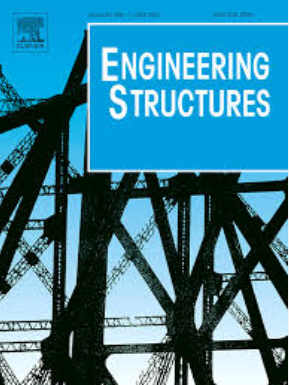Three-dimensional dynamic analysis of transmission tower based on separation of background and resonant components of non-stationary downburst-induced response
IF 5.6
1区 工程技术
Q1 ENGINEERING, CIVIL
引用次数: 0
Abstract
Transmission towers are vulnerable to the downburst, which highlights the importance of the investigation into the dynamic response of the structure suffering the non-stationary downburst action. Compared to the stationary downburst, the non-stationary downburst would raise the concerns that more wind parameters and substantial random samples of stochastic excitation would be involved in the time-domain dynamic analysis, leading to more attention to be paid on the computational efficiency. Therefore, this study aims to achieve a reliable approach for quickly approximating the time-varying variance of the transmission tower response under the non-stationary downburst, based on the separation of background and resonant components. Using the deterministic stochastic hybrid model (DSHM), the modulation function of the non-stationary downburst-induced wind loads is first derived in an analytical manner, and found to be composed of both the part resulting from the amplitude-modulated fluctuating wind and the part originating from the time-varying wind incidence angle due to the downburst’s motion. In association with the modal superposition method, the frequency-domain analysis method based on the reduced-order (in modal space) system is presented with consideration of the stochastic evolutionary spectrum, and the obtained variance response results agree well with the corresponding time-domain results obtained via the full-order system (finite element model). By implementing the theory of equivalent band-pass filter, the stochastic evolutionary spectrum-based background-resonance method is derived, which is found to be valid in the context of well separated natural frequencies, i.e., the equivalent bandwidths are not overlapped. Furthermore, it is revealed in theory that the background response is essentially the quasi-static fluctuating response of the structure under the fluctuating wind loads, which is corroborated by the numerical results. In addition, a closed-form formula is proposed for approximating the covariance of the stochastic wind velocity that is in compliance with Kaimal’s spectrum. Thereby, all the calculations in the background-resonance method would be algebraic, which makes it easy to compute the variance response. Note that the application of the background-resonance approach presented herein to the transmission towers can be easily extended to that to the other complex structures. Finally, the validation of the methodologies presented herein is verified by the case study.
求助全文
约1分钟内获得全文
求助全文
来源期刊

Engineering Structures
工程技术-工程:土木
CiteScore
10.20
自引率
14.50%
发文量
1385
审稿时长
67 days
期刊介绍:
Engineering Structures provides a forum for a broad blend of scientific and technical papers to reflect the evolving needs of the structural engineering and structural mechanics communities. Particularly welcome are contributions dealing with applications of structural engineering and mechanics principles in all areas of technology. The journal aspires to a broad and integrated coverage of the effects of dynamic loadings and of the modelling techniques whereby the structural response to these loadings may be computed.
The scope of Engineering Structures encompasses, but is not restricted to, the following areas: infrastructure engineering; earthquake engineering; structure-fluid-soil interaction; wind engineering; fire engineering; blast engineering; structural reliability/stability; life assessment/integrity; structural health monitoring; multi-hazard engineering; structural dynamics; optimization; expert systems; experimental modelling; performance-based design; multiscale analysis; value engineering.
Topics of interest include: tall buildings; innovative structures; environmentally responsive structures; bridges; stadiums; commercial and public buildings; transmission towers; television and telecommunication masts; foldable structures; cooling towers; plates and shells; suspension structures; protective structures; smart structures; nuclear reactors; dams; pressure vessels; pipelines; tunnels.
Engineering Structures also publishes review articles, short communications and discussions, book reviews, and a diary on international events related to any aspect of structural engineering.
 求助内容:
求助内容: 应助结果提醒方式:
应助结果提醒方式:


